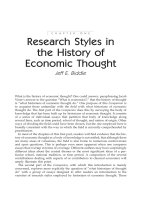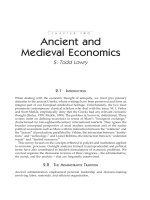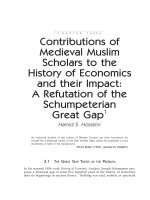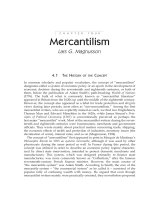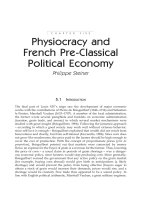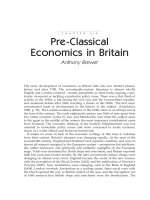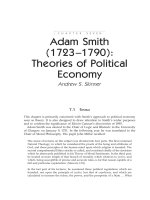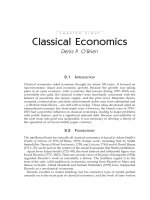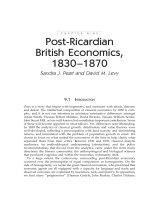A Companion to the History of Economic Thought - Chapter 31 pdf
Bạn đang xem bản rút gọn của tài liệu. Xem và tải ngay bản đầy đủ của tài liệu tại đây (192.26 KB, 15 trang )
EXEGESIS, HERMENEUTICS, AND INTERPRETATION 523
CHAPTER THIRTY- ONE
Exegesis,
Hermeneutics,
and Interpretation
Ross B. Emmett
31.1 INTRODUCTION
Before you on the desk sits an economics text. It may be the most recent article in
a journal or a classic book in the discipline. If you are like most readers, your
concern as you read is to make sense of what the text says. This is the central task
of textual interpretation: to make sense of the meaning of a text.
The other two words of our title are closely associated with interpretation,
although they are used less frequently in economics than in the humanities.
“Exegesis” refers to the critical analysis of a text, and hence is an integral part of
the interpretive task. Exegesis takes us beyond reading the text to attending to
its genre, style, form, word choice, model assumptions, internal logic, and con-
textual issues. Because the exegetical task forces one to pay close attention to the
text, an exegesis usually focuses on one particular passage (or, in the case of
contemporary economics texts, one model) in an author’s work. “Hermeneutics,”
on the other hand, most often refers to the study of the methods or principles of
interpretation. It may be thought of as the methodology of interpretation. Because
this essay will focus on the methodologies of interpretation in the history of
economics, it is primarily an essay in hermeneutics.
The close relation of methodological studies to philosophy has led to a
hermeneutic tradition in philosophy, which assumes the primacy of the interpret-
ive stance. Hermeneutic philosophy is founded on the notion that all knowledge,
not only knowledge of the meaning of a text, is a process of interpretation – there
are only interpretations and their reinterpretations. While its philosophic roots
lie in the nineteenth century, especially in the work of Wilhelm Dilthey (1976),
524 R. B. EMMETT
twentieth-century hermeneutic philosophy is dominated by the contrast between
the work of Hans-Georg Gadamer (1989) and Jacques Derrida (1976; see also
Michelfelder and Palmer, 1989). Banished from economics during the positivist
orientation of the postwar period, hermeneutic philosophy has made some inroads
into contemporary economics, especially among Austrian economists. The inter-
action of hermeneutic philosophy and economics lies outside the scope of this
essay, but the interested reader can consult Lavoie (1991) and Gerard (1993).
But let us return to the text before you. Most readers obtain a satisfactory
understanding of a text by reading it for themselves. Even if the text is written in
a style that is unfamiliar to the modern reader, or uses some specific tools and
terminology unique to a sub-field of the economics discipline, you probably picked
it up with the confidence that its meaning would be clear to you, even if you
have to do a bit of exegetical work to ferret the meaning out.
Yet, while making sense of a text’s meaning seems to be a simple process,
it can be fraught with difficulty. One of the prime difficulties was expressed well
by the Christian reformer Samuel Werenfels, about 400 years ago, with reference
to the Bible: “Men ope this book, their favourite creed in mind; Each seeks his
own, and each his own doth find.” Werenfels’s observation is as true of the
reading of canonical texts in economics as it is of sacred religious texts. One can
find in many of the seminal works of economics passages that lend credence to
any number of economic theories. And the literature of the history of economic
thought is filled with “new” interpretations of classic texts which demonstrate how
a historical author agrees with one or another contemporary theory. Invariably,
the contemporary theory the classical text is said to “anticipate” is the author’s
own! How can we distinguish between what we think these authors’ works
mean, and what they really mean?
31.2 STIGLER’S PRINCIPLE OF SCIENTIFIC EXEGESIS
One starting point for answering that question is found in the work of George
Stigler. In “Textual exegesis as a scientific problem,” Stigler (1965) addressed the
problem of choosing among competing interpretations of a portion of an author’s
work. Stigler clearly has Werenfels’s problem in mind when he points out that
one can find in many authors’ works individual passages that seem to support
widely different theoretical conclusions. How should those passages be inter-
preted? Which of them should be given prominence? Stigler likens the problem
of textual exegesis in this regard to the problem of the single fact in statistical
work. In order to increase your confidence in a statistical test, you increase the
sample size. Similarly, in order to increase your confidence in a particular inter-
pretation of a text, you increase the amount of the author’s work taken into
consideration. “We increase our confidence in the interpretation of an author by
increasing the number of his main theoretical conclusions which we can deduce
from (our interpretation of) his analytical system” (Stigler, 1965, p. 448).
Stigler goes on to provide a method for applying his “principle of scienti-
fic exegesis” (Stigler, 1965, p. 448), illustrated in figure 31.1. First, the “general
EXEGESIS, HERMENEUTICS, AND INTERPRETATION 525
Formal statement – capable of empirical testing
Scientific exegesis
Comparison with
contemporary economic
knowledge to determine net
benefit to economics
Personal exegesis
Comparison with author’s style
General position
Author’s work
Figure 31.1 Stigler’s hermeneutic approach
position” of the author under study is established. A general position is the
theoretical core of an author’s work, restated in a manner compatible with con-
temporary economic theory. The general position will probably not be formally
stated in the author’s own work, but will have to be constructed by interpreters
from the various elements of the author’s work. Nevertheless, Stigler appears
confident that, at any given time, the economics community will recognize what
the general positions of past economists are, especially in the case of significant
figures such as Adam Smith, David Ricardo, Karl Marx, Léon Walras, or John
Maynard Keynes. Once the author’s general position is identified, it can be stated
in “a strong form capable of contradictions by the facts” (Stigler, 1965, p. 448).
At this point, Stigler argues that two different interpretive activities can occur.
First, contemporary theorists can examine the relation between the author’s gen-
eral position and what the modern discipline knows about the economy. The
interpretation of the author’s general position allows us to evaluate how it can
be (has been) amended or improved to explain a greater portion of modern
economic life. If the author’s general position survives comparison with contem-
porary economic knowledge, we can say that the author has had a net positive
impact on the modern discipline. On the other hand, if the modern discipline’s
knowledge falsifies the author’s general position, the interpretation allows us to
say that the author’s work has made no lasting contribution to economics.
The other interpretive activity which can occur once the author’s general posi-
tion has been stated in a strong form is the evaluation of the consistency of the
author’s own conclusions. Theorists often make logical mistakes, or hold beliefs
that are later proven false. Should the classical economists’ “iron law of wages,”
or Stanley Jevons’s sunspot theory of the business cycle, lead us to reject their
526 R. B. EMMETT
entire theoretical work? Certainly not. While economic science may winnow this
chaff through the process of testing the author’s general position, some inter-
preters may be interested in figuring out exactly what the original author really did
believe, even when it is wrong by today’s standards. Where contradictory passages
in an author’s work are encountered during this type of interpretive work, Stigler
says his principle of scientific exegesis provides no guidance, because the net
benefit to modern economics is not the interpreter’s concern. In its place, he
suggests that the interpreter choose as “decisive” an interpretation that fits well
with the author’s “style” of thought. Stigler calls this rule “the principle of per-
sonal exegesis” (Stigler, 1965, p. 448). We will return to the theme of personal
exegesis later in the essay.
31.3 STIGLER AND THE HERMENEUTIC CIRCLE
Stigler’s principle of scientific exegesis provides a strong hermeneutic program
for the evaluation of the contribution of past economic work to the current discip-
line. However, there is a fly in Stigler’s exegetical ointment. Notice in figure 31.1
the prominent role that the author’s “general position” plays. While this theoret-
ical framework is derived from the author’s work, it also plays a governing role
in the interpretation of specific passages in the author’s work (note the feedback
loop from the general position to the author’s work through both personal and
scientific exegesis). Which comes first, the text or the general position?
In Stigler’s formulation, there is an implicit assumption that the interpreter
already knows the author’s “general position” before she begins to interpret a
specific passage of the text. A seemingly innocuous assumption, this actually
points to one of the central issues in hermeneutics, which has generated much of
the most interesting work in hermeneutic theory. Put differently, Stigler assumes
that if you are to make sense of any portion of the text before you, you need to
have some prior understanding of what the text is generally about. But how are
you to acquire a general understanding of the text without understanding all
the passages within the text? We call this dilemma the “hermeneutic circle”:
understanding any portion of a text requires knowledge of all of the text, under-
standing all of the text requires knowledge of every portion of the text.
Methodologically, the problem posed by the hermeneutic circle is a question
of how you break out of the hermeneutic circle. Is there a means of avoiding the
trap? Stigler’s assumption that the interpreter has prior knowledge of the author’s
general position comes quite close to the answer to this question provided by
Paul Ricoeur (1981) in his synthesis of hermeneutic philosophy. Drawing upon
the hermeneutic tradition of Dilthey, Gadamer, Martin Heidegger (1962), and
others, Ricoeur accepts the dilemma expressed in the problem of the hermeneutic
circle, but suggests that the dilemma’s resolution lies not in the metaphor of
“breaking out” but, rather, in one’s “entrance into” the circle. He argues that
the interpreter must enter the circle with the right pre-understanding of the text.
You come to the text before you with an anticipation of what it may hold; an
anticipation shaped by your familiarity with other texts and with an interpretive
EXEGESIS, HERMENEUTICS, AND INTERPRETATION 527
community. Quoting Heidegger, Ricoeur (1981, p. 58) says, “what is decisive is
not to get out of the circle but to come into it in the right way.” But this only
pushes our methodological question back one level, for now we have to ask:
What is the “right way” to come into the hermeneutic circle?
Stigler’s response to the question of the “right way” for an economist to gain a
pre-understanding of economics texts is best expressed in another essay (Stigler,
1982). There, in an investigation of the possible uses of biography in the study of
the history of economics, Stigler argues that the meaning of a text is determined
not by the individual interpreter or even the original author, but by the scientific
community of economists, as they read and re-read the text over time: “The
recipients of a scientific message are the people who determine what the message
is . . .” (Stigler, 1982, p. 91). For economists, then, the right pre-understanding of
authors’ general positions is provided to the interpreter by the economics profes-
sion. That scientific community is best positioned, Stigler argues, to understand
the scientific meaning of a text. So the modern interpreter enters the hermeneutic
circle as an economist with the profession’s pre-understanding of the scientific
meaning of the author’s work in hand.
We have come full circle with Stigler. The methodological principle of sci-
entific exegesis calls for us to use the author’s text as a testing ground for the
analytic framework that the economics profession has identified with the author.
If we can show that the author’s theoretical conclusions are deducible from the
general position ascribed to the author, and these theoretical conclusions stand
up against what the modern profession knows of the economy, we can say that
the author has made a positive net contribution to modern economics. Where
these conclusions need modification or improvement, we can show that the eco-
nomics profession has progressed beyond the author’s original work. Both history
and progress, then, emerge from the exegetical work associated with identifying
the author’s general position.
31.4 THE MYTHOLOGY OF COHERENCE
Stigler’s argument that the interpreter’s pre-understanding of an economics text
should depend upon the general position ascribed to the author by the economics
profession is, however, problematic. The first reason we should be suspicious of
Stigler’s notion regarding the pre-understanding of the general position focuses
on the problematic nature of the “general position” itself. Where does one find the
general position within the author’s work? It is rarely said to be in one specific
passage; rather, one finds pieces of it scattered over the length and breadth of
the author’s career. But why choose those pieces and not others? What do you do
with statements that modify parts of the general position, or with other statements
that we can show to contradict the general position? We are, of course, right back
to Stigler’s original problem – the hermeneutic circle. But, why, we ask, did the
author not simply make her general position clear herself?
To use Stigler’s own statistical style of discourse, the central problem with
the notion of distilling a general position from an author’s work is one of
528 R. B. EMMETT
over-determination. Just as there are several hypotheses that can account for
a specific set of data, there are always several possible general positions that can
be constructed from any author’s work. Increasing the sample size (the range of
the author’s work taken into consideration) simply increases the probability that
competing general positions cannot be ruled out.
A general position, therefore, is an abstraction from the texts that comprise the
author’s work. In keeping with Stigler’s characterization, Don Patinkin (1982,
p. 17) once described it as the attempt “to pass a regression line through a scholar’s
work that will represent its central message.” Ignoring the author’s own interests
and audience, the interpreter abstracts a general position from an author’s texts;
giving the author’s work a coherent meaning that the author never actually thought
at any particular moment in time and could in fact disagree with. The search for
a coherent general position for the purpose of evaluating scientific progress is
labeled by Quentin Skinner (1988) as the construction of a “mythology of coher-
ence.” While we may assume that no author deliberately contradicts herself in
order to make her contemporary or future interpreters confused, we must also
accept the fact that no author’s work is handed down to us from “on high” –
written in a single moment and with a God-like recognition of all the intercon-
nections among the work’s many parts. Skinner remarks that such mythologies
become histories “not of ideas at all, but of abstractions: a history of thoughts
which no one ever actually succeeded in thinking, at a level of coherence which
no one ever actually attained” (Skinner, 1988, p. 40).
If we take the passage of time in an author’s work seriously, and reconstruct
specific passages on their own merits (even when they are at odds with passages
written earlier or later in the author’s life), it is unlikely that we will end up
creating a mythical general position. Anthony Waterman caught Skinner’s point
well when he remarked, in responding to a criticism of his interpretation of a
particular passage in Malthus:
There is a great temptation to tidy up the creative mess left behind by men like
Malthus. But Quentin Skinner . . . has warned historians of ideas to resist that tempta-
tion. For to succumb to what he called the “mythology of coherence” would be
to impose a far greater distortion upon the material than that minimum that must
inevitably be inflicted when we attempt to pin down a coherent subset of our author’s
work. Those of us who accept this methodological rule will content ourselves with
lots of little snapshots, like “Mr. Keynes and the Classics”; and will remain unre-
pentantly sceptical of all attempts to inform us of “What Malthus (Keynes, Marx,
et al.) Really Meant.” (Waterman, 1988, pp. 206–7)
31.5 INTERLUDE: “LITTLE SNAPSHOTS” – RATIONAL RECONSTRUCTION
While there are a couple more problems with the search for general positions
that need to be examined, Waterman’s suggestion that we “content ourselves
with lots of little snapshots” provides an opportunity to point out a positive
hermeneutic application of Stigler’s principle of scientific exegesis. You may, in
fact, already have thought to ask this question: What if the interpretive goal is
EXEGESIS, HERMENEUTICS, AND INTERPRETATION 529
more modest than the construction of a general position that spans the author’s
entire work? What if you simply want to bring a subset of the author’s work
– one particular text, or a small group of texts – into dialogue with current eco-
nomics? Could we thereby avoid the mythology of coherence trap that is inher-
ent in a general position? In order to distinguish this less ambitious interpretive
task from the construction of general positions, we will give it the label “rational
reconstruction.” Originally introduced by Richard Rorty (1984), the term rational
reconstruction is used here in a narrower sense than it is by Blaug (1990), who
applies it to any interpretation adopting the concerns of current economics as
its primary hermeneutic stance, including the search for past authors’ general
positions.
As interpretive exercises, rational reconstructions differ from the construction
of general positions in four important ways. First, rational reconstructions, as
suggested by Waterman’s phrase, focus on a subset of a past author’s work.
Whether it is one book or article, or a group of articles written at about the same
time, the text chosen for a rational reconstruction is not chosen because it best
represents the author’s general position; the interpreter’s goal is simply to bring
that particular text into dialogue with present-day concerns. A narrower focus
prevents abstractions that move too far away from the texts under consideration.
In this sense, a rational reconstruction is still governed by the texts in a way that
a general position may not be.
Secondly, the interpreter’s task in a rational reconstruction is not the construc-
tion of a theoretical position from the past author’s work that can be contrasted
with current knowledge but, rather, the reconstruction of the past author’s argu-
ment in a modern theoretical framework. Mathematical modeling techniques and
theoretical concepts unknown to the original author may appear in the rational
reconstruction, and aspects of the author’s argument that the interpreter knows
to be mistaken may be replaced with more defensible propositions. Reconstruc-
tion, then, is an appropriate term for this interpretive exercise: the author’s work
will not appear as it did in the original, but will be rendered intelligible to the
modern economic theorist.
Thirdly, the selection of techniques and concepts used to cast the author’s
work in modern garb by each interpreter implies that multiple rational recon-
structions of an author’s work may be possible. We saw earlier that the possib-
ility of multiple general positions from an author’s work poses a problem for
interpreters who are seeking an abstract coherent theoretical framework from the
entirety of an author’s work. In the case of rational reconstructions, the existence
of differing interpretations emerges from the choices made by the interpreter. If
one were to compare rational reconstructions, the relevant comparison would be
which reconstruction makes the original author’s work more useful to the needs
of the modern economics community (Emmett, 1997).
Finally, because rational reconstructions focus on particular parts of authors’
work and bring that work into dialogue with contemporary scholarship, they
are less likely to be used as an indicator of the degree of scientific progress from
the past to the present. The connection between Stigler’s principle of scientific
exegesis, the search for general positions, and the notion of scientific progress
530 R. B. EMMETT
will be mentioned in a subsequent section. Rather than setting the past author up
for a damning comparison, a rational reconstruction makes the author our contem-
porary, and forces us to confront the fact that we may not know something that
she did. Because rational reconstructions deliberately rewrite past authors’ work
in the language of current science in order to challenge current theory, we might
think of them as the use of the past to advance toward the future, rather than a
judgment upon the past from the standpoint of the present.
31.6 HERMENEUTIC AUTHORITY AND THE HERMENEUTICS
OF
SUSPICION
A second reason why Stigler’s notion of the pre-understood general position is
problematic emerges from the role that it assigns to the economics profession
as the final arbiter of meaning. If the economics profession governs the pre-
understanding that we bring to the text before us, will that scientific community
be willing to give a legitimate hearing to a new interpretation of a well-known
text? (“We” know Adam Smith, and this is not the Smith “we” know.) Can a
new interpretation of an author cause the profession to reevaluate a canonical
author’s position relative to contemporary work? Ricardo serves as a good
example, because Stigler himself assumes that we “know” Ricardo. Yet, even in
Stigler’s lifetime, a fundamental reinterpretation of Ricardo’s work was under way,
led by Samuel Hollander (1979). The new “Ricardo” is at odds with Stigler’s
own “Ricardo,” and would likely be judged to have had a greater net contribu-
tion to modern economic thought than Stigler might have allowed. Stigler also
dismissed the contribution of American institutionalists to postwar economics,
but more recent studies have created linkages between them and the emergence
of the New Institutionalism (Rutherford, 1994). If the scientific community
determines the meaning of the text, can these studies change the community’s
pre-understanding?
The notion of the economics profession as the final arbiter of meaning is
problematic, therefore, because it gives hermeneutic authority to one specific inter-
pretive community (see Fish, 1980). On what basis are we to accept the authority
of the economics profession as an arbiter of meaning for economics texts? Are we
to accept its authority because of the validity of current economics theory, its
practioners’ knowledge of the texts, their interpretive skills and balanced appre-
ciation for the net benefit of past theorists’ work – or simply because we are
economists? These questions were raised in an interesting way several years ago,
when an English professor at Harvard University held a conference on Adam
Smith. The title of the conference was “Who Owns Adam Smith?” and only a few
historians of economics were among the invited speakers.
Similarly, why should economists yield hermeneutic authority to other discip-
lines over texts that might contribute to our understanding of economics? His-
torians of economics have sometimes been reluctant to accept the contribution of
“noneconomics” texts to the history of economics. This reluctance may stem from
another implication of Stigler’s principle: economists are not the recipients of the
EXEGESIS, HERMENEUTICS, AND INTERPRETATION 531
message of noneconomics texts, and therefore are unqualified to interpret them.
Unpublished manuscripts, correspondence, government reports, magazine articles,
and teaching materials provide a rich resource for understanding the meaning of
published texts (Weintraub et al., 1998), but were often ignored until recently,
because historians of economics accepted Stigler’s argument that biographical
material would divert them from the task of assessing the scientific validity of
the abstracted general position (Stigler, 1982). In like manner, nonscholarly dia-
logue by economists and others on public policy has often also been ignored by
historians of economics, because neither the economists’ contributions nor other
commentary were “economics” proper. The acceptance of this artificial dichotomy
between economics and noneconomics texts left historians of economics handi-
capped in their efforts to interpret texts, because they missed opportunities to
study sources that might assist them. A recent study of the origins of the “dismal
science” by one of Stigler’s former students provides an excellent example of the
implications of our ignorance of this dichotomy (Levy, 2001).
Even within the community of economists, there are problems with the herm-
eneutic authority of mainstream economics’ interpretation of particular authors.
The magisterial voice that Stigler adopts suggests to the historian of economics
that the pre-understanding of an economics text comes from the economics pro-
fession because that scientific community speaks with one voice. However, the
notion of one community, one voice is as problematic as that of hermeneutic author-
ity. The various schools of economics interpret past authors quite differently, and
historians of economics in the past 40 years have shown remarkable diversity
in their interpretations of past economists’ writings. The past is often the stage
on which the debates of the present are contested. Once again, the interpretation
of Ricardo is a good example, with at least two, if not three, different Ricardian
theoretical frameworks articulated in the literature. Furthermore, the differences
among these different “general positions” usually parallel the theoretical differ-
ences between different schools of economics (for a plea to make this contest the
center of the history of economics, see Roncaglia, 1996).
Is there a way to avoid the proliferation of “general positions” ascribed to
canonical texts among competing contemporary schools of economics? As long
as the focus of interpretation is on the construction of a general position that
can be used to identify the author’s net benefit to modern economics (Stigler’s
hermeneutic principle), the answer is probably “No.” However, we can gain
something by turning this question around somewhat, and looking at the issue
from a different angle. Rather than looking at the various general positions
ascribed to an author by the different schools of economics and arguing over
their relative merits, we might ask of any particular general position the follow-
ing questions: What aspects of the author’s work does this interpretation obscure
from view? What does it hide? These questions engage the reader in what, fol-
lowing Ricoeur (1970, pp. 32–3), might be called the “hermeneutics of suspicion.”
If interpretation is the act of focusing attention on certain themes in a work, then
necessarily it is also the act of leading one’s attention away from other themes in
the work. One task an interpreter can undertake is that of uncovering in an
author’s work that which the “general position” ascribed to the author has missed.
532 R. B. EMMETT
31.7 WHIG HISTORY
The third problem with Stigler’s hermeneutic program relates to the issue of
scientific progress and the present-day scientific community’s appreciation of the
past on its own terms. Stigler’s mentor in the history of economics, Frank H.
Knight, began his essay on classical economics with the words: “On the assump-
tion that the primary interest in the ‘ancients’ in such a field as economics is to
learn from their mistakes, the principal theme of this discussion will be the
contrast between the ‘classical’ system and ‘correct’ views” (Knight, 2000, p. 237).
Stigler’s principle of scientific exegesis articulates the hermeneutic program behind
these words, a program designed to interpret the contribution of authors and key
works to the progress of economic science. By identifying the key interpretive
question as the determination of an author’s net benefit to modern economic
science, Stigler implicitly sets a standard for scientific progress: present-day theory
stands as the judge of the past. More than likely, no past author will escape the
interpreter’s knife entirely (for contrasting views of the importance of progress
for the historian of economics, see Winch, 2000; Hynes, 2001).
A history that allows present-day theory to be the judge of the past is often
called a Whig history. The term, picked up from Herbert Butterfield’s (1931) study,
has been a subject of debate among historians of economics since Paul Samuelson
(1987) first introduced it. Much of the discussion has been complicated by the
conflation of two different problems. The first, often called presentism, refers to a
theme already introduced in this essay; namely, the practically inevitable present-
day concerns embedded in a pre-understanding that the interpreter brings with
her to the study of past texts. But Butterfield’s concern was not with presentism
per se; he acknowledged that all history shares this problem, and that present-day
concerns often do provide a motivation for historical investigation. Whig history
is a particular type of presentism; one that makes the historian’s present-day
perspective the judge of the past. In a Whig history, the goal of the interpreter is
to praise those who have significant net contributions and to condemn those
whose contributions have been discarded on the waste heaps of historical progress.
Although Stigler’s principle of scientific exegesis need not be used for Whiggish
purposes (rational reconstructions usually avoid the charge of Whig history), it
often is. As Frank Hahn recently said: “What the dead had to say, when of value,
has long since been absorbed, and when we need to say it again we can generally
say it much better” (Hahn, 1993, p. 165). Stigler would not have put it better.
31.8 ABANDONING WHIG HISTORY, AND THE SEARCH FOR
GENERAL POSITIONS
So far, we have asked what sense you as a member of the contemporary community
of economists can make of a past economist’s work. Stigler’s principle of scien-
tific exegesis was our starting point, and we have examined the pitfalls such as
mythologies of coherence and Whig history into which it may lead us. While the
EXEGESIS, HERMENEUTICS, AND INTERPRETATION 533
legitimacy of general positions, Whig history, and notions of progress in the
history of economics remain topics of debate (see Henderson, 1996; see also the
discussion on history of economics readers in the August 2001 and September
2001 archives of the HES email list), some historians of economics have abandoned
the attempt to assess the past in terms of the present, and opted instead for what
has been called “historical reconstruction” (Rorty, 1984). Choosing to make the
past their present, these historians of economics focus on reconstructing the mean-
ing of texts at specific moments in time in the past (for a contribution that helped
to turn historians’ attention in this direction, see Weintraub, 1991).
Until recently, studies that focused on a text’s relation to its own context
were considered to be “external” or “relativist” history (Blaug, 1985). The critics
of external history condemned the deterministic linkage made in such studies
between a text and its social, political, cultural, and intellectual contexts (for
example, that Keynes’s The General Theory arose from the Great Depression). Ideas,
it was said, have their own history; telling the story of an idea’s development
was “internal” or “absolutist” history (Blaug, 1985). However, there is a difference
between arguing that ideas are determined by their context and interpreting the
historical meaning of texts. Rather than seeking the link between ideas and his-
torical events, historical reconstructions seek to reconstruct the sense (meaning)
that someone gave a particular text at some historical point. The most obvious
form of historical reconstruction is the effort to understand the original author’s
meaning. But there are other forms of historical reconstruction as well. For ex-
ample, we might want to ask what sense public policy-makers in the 1940s made
of Keynes The General Theory, or what Piero Sraffa (1951) made of David Ricardo.
We might also be interested in what contemporaries of the original author made
of the text when it appeared. Our interest in these questions leads us to try to
make sense of the meaning that someone other than ourselves (and in many cases,
other than a present-day economist) gave to a text.
To examine the hermeneutic issues related to historical reconstruction, we will
focus on the reconstruction of the original author’s meaning. The same prin-
ciples apply to other historical reconstructions. We can ask initially if Stigler’s
aforementioned principle of personal exegesis provides the basis for the historical
reconstruction of the original author’s meaning. Although we have concluded
that scientific exegesis is problematic, might personal exegesis yet help us to
construct a coherent account of the author’s own theoretical conclusions (wrong
as they may be!)?
Stigler, you may remember, suggested that after determining an author’s general
position, it would be possible to go back and examine whether the conclusions
of the general position match up with the author’s own conclusions. Putting
aside the issues that we have already addressed regarding the determination of a
general position, we will focus here instead on Stigler’s suggestion that the appro-
priate guide to follow in personal exegesis is the author’s “style.” Economists are
not accustomed to analyzing a writer’s style as part of their exegetical work, but
style has reentered economics discourse in the rhetorical work of D. N. McCloskey
(1998). McCloskey points out that every writer adopts an “ethos” or persona in
her writing. A writer’s “style” emerges from the authority or trustworthiness of
534 R. B. EMMETT
the ethos to which she appeals. Nineteenth-century writers wrote in a plain style:
educated readers addressing their equals. Modern economists adopt a style that
deflects attention from the writer toward the authority of the “scientific ethos”
provided by the community of economists (McCloskey, 1998, pp. 10 –11).
Because style depends, at least in part, upon the author’s rhetorical community,
Stigler’s notion of personal exegesis naturally takes us into an examination of
the author’s intellectual and social context. What concerns the interpreter inter-
ested in historical reconstruction is the range of meanings of words and concepts
that were available to the author at the time she wrote her text. The term “uncer-
tainty,” for example, has a more specific meaning within economics today than it
did in the early twentieth century, when Frank Knight (1921) wrote his famous
treatise on the subject. If we wish to reconstruct Knight’s treatment of uncer-
tainty historically, we will have to make ourselves aware of the range of mean-
ings that he may have drawn on, rather than assuming that he shared the current
discipline’s understanding of the term (Emmett, 1997). While we may not be
willing to go as far as Michel Foucault (1972, p. 129) in arguing that the linguistic
structure in which Knight operated governed the possible meanings that could
be assigned to his text, we can agree that the disciplinary discourse of uncer-
tainty in the 1910s will have to be placed in the context of the term’s meaning
within a larger social and philosophic discourse (for examples, see Kloppenberg,
1986). J. G. A. Pocock (1962, 1985) has made this type of linguistic contextualism
the cornerstone of his historiography, which has made significant inroads into
the history of economics, especially the history of its early period (see Winch,
1996).
While we may agree with Pocock and Foucault that the discursive context
and linguistic structure within which a past author worked limit the range of
meanings and usages to which the author had access, the key issue for most
historians of economics is what the author did with the meanings at her disposal.
It is not just the meaning of concepts and structure of the language that are
important, but their use. To return to the example of Knight’s notion of uncer-
tainty, we recognize that he took notions of indeterminacy and voluntary action
that were attached to the notion of uncertainty outside the realm of economics
and brought them together in the introduction of a new concept within eco-
nomics. A historical reconstruction of his work would then recognize the new use
within economics of a term previously associated with other discourses. Hence,
while we as interpreters cannot avoid the examination of an author’s intellectual
and linguistic context in the process of writing an historical reconstruction, we
must in the final analysis make sense of the particular way in which the author
used those concepts and spoke within that linguistic context to communicate to
her contemporaries what she meant.
The guiding hermeneutic principle of historical reconstruction is Quentin
Skinner’s: “The relevant logical consideration is that no agent can eventually be
said to have meant or done something which he could never be brought to accept
as a correct description of what he had meant or done” (Skinner, 1998, p. 48). To
make it clear that hermeneutic authority is given here to the original agent,
Skinner adds that his principle requires that “any plausible account” the interpreter
EXEGESIS, HERMENEUTICS, AND INTERPRETATION 535
may provide “of what the agent meant must necessarily fall under, and make use
of, the range of descriptions which the agent himself could at least in principle
have applied to describe and classify what he was doing” (Skinner, 1998, p. 48).
While this principle bears some resemblance to Stigler’s principle of personal
exegesis, Skinner argues that one should examine the author’s use of words rather
than the author’s style (for comparison of Skinner’s approach to Pocock and
others, see Tully, 1988; Bevir, 1999). Skinner’s question is: What was the author
trying to do by using the words she used?
Answering Skinner’s question often requires a richly textured study of the text
that examines its relation to the author, the author’s discursive community, and
the social context within which the author lived at the time of writing the text.
A wide variety of literature will assist the interpreter; including published texts
(scholarly and otherwise), unpublished manuscripts, correspondence, curricular
materials, pictures, interviews, and other materials. The anthropologist Clifford
Geertz (1973) has called such studies “thick” descriptions; the term is an appro-
priate contrast to the thin abstractions of general positions.
31.9 CONCLUSION
At the beginning, we considered an economics text sitting on the desk in front
of you. Making sense of that text appeared to be a straightforward problem of
reading carefully. By now, however, you may wonder what sense, or how many
senses, you can make of the text! The problems that we have considered challenge
any interpretation you may attempt, be it the construction of a general position
along Stiglerian lines, a rational reconstruction, or a historical reconstruction. In
conclusion, then, perhaps it is appropriate to summarize and emphasize the
positive aspects of the issues we have considered.
First, as interpreters, we cannot escape the concerns of the times in which we
live. We live in the present, and our historical interests are often animated by our
present-day concerns. But the interpreter does have a choice as to whether she
will interpret the text from the perspective of the present. Where the interpreter’s
interest is in bringing an historical author’s work into dialogue with current
economics, Stigler’s principle of scientific exegesis is an appropriate guide. How-
ever, there is a thin line between rationally reconstructing the author’s work in a
way that enables the interpreter to identify its relation to modern thought and
adopting the judgmental voice of Whig history. The latter should be avoided
when the former is undertaken.
Secondly, whether the interpreter seeks to reconstruct the contemporary
meaning of a text (rational reconstruction) or a historical meaning (historical
reconstruction), less is more. The creation of a general statement of the author’s
position inevitably leads the interpreter to create a mythology; an abstraction
from the author’s work that will be upheld by appeal to some texts, but almost cer-
tainly falsified by others. Careful exegesis of specific texts, considering the range
of meanings that they might have, the context in which they were created, and the
purposes to which the author (or past interpreter) may have put them, will serve
536 R. B. EMMETT
the interpreter well. Ironically, perhaps, abstract general positions turn out to be
thinner representations of an author’s work than either the contemporary render-
ing provided by a good rational reconstructions or the richly textured accounts
that emerge from a good historical reconstruction.
Finally, the act of interpretation is a humbling experience. When we recognize
the contingencies that shape the texts that we interpret, we also realize that
our own ideas are limited by the context in which we live. And when the past
speaks to us, we learn that others thought well – sometimes even better than
we do.
Note
The author wishes to thank Bruce Janz and Anthony Waterman for conversations that
enriched the views expressed here.
Bibliography
Bevir, M. 1999: The Logic of the History of Ideas. Cambridge, UK: Cambridge University
Press.
Blaug, M. 1985: Economic Theory in Retrospect. Cambridge, UK: Cambridge University Press.
—— 1990: On the historiography of economics. Journal of the History of Economic Thought,
12, 27–37.
Butterfield, H. 1931: The Whig Interpretation of History. London: Pelican.
Derrida, J. 1976: Of Grammatology. Baltimore, MD: Johns Hopkins University Press.
Dilthey, W. 1976: Selected Writings. Cambridge, UK: Cambridge University Press.
Emmett, R. B. 1997: Reflections on “breaking away”: economics as science and the history
of economics as history of science. Research in the History of Economic Thought and Meth-
odology, 15, 221–36.
Fish, S. 1980: Is There a Text in This Class? The Authority of Interpretive Communities. Cam-
bridge, MA: Harvard University Press.
Foucault, M. 1972: The Archaeology of Knowledge. London: Tavistock.
Gadamer, H G. 1989: Truth and Method, 2nd revised edn. New York: Crossroad.
Geertz, C. 1973: The Interpretation of Culture: Selected Essays. New York: Basic Books.
Gerrard, B. 1993: The significance of interpretation in economics. In W. Henderson,
T. Dudley-Evans, and R. Backhouse (eds.), Economics and Language. London: Routledge,
51–63.
Hahn, F. 1993: Autobiographical notes with reflections. In M. Szenberg (ed.), Eminent
Economists. Cambridge, UK: Cambridge University Press.
Heidegger, M. 1962: Being and Time, revised edition. New York: Harper & Row.
Henderson, J. 1996: Whig history of economics is dead – Now what? />HE/hes_list/Editorials/henderson.php
Hollander, S. 1979: The Economics of David Ricardo. Toronto: University of Toronto Press.
Hynes, A. 2001: Economics’ past and present: historical analysis and current practice.
Journal of the History of Economic Thought, 23, 181–95.
Kloppenberg, J. 1986: Uncertain Victory: Social Democracy and Progressivism in European and
American Social Thought 1870–1920. New York: Oxford University Press.
Knight, F. H. 1921: Risk, Uncertainty, and Profit. Boston: Houghton Mifflin.
—— 2000: The Ricardian theory of production and distribution. In R. B. Emmett (ed.),
Selected Essays by Frank H. Knight, vol. 1: “What is Truth” in Economics? Chicago: The
EXEGESIS, HERMENEUTICS, AND INTERPRETATION 537
University of Chicago Press, 237–89. Originally published in the Canadian Journal of Eco-
nomics and Political Science, 1 (February and May 1935), 3–25 and 171–96.
Lavoie, D. (ed.) 1991: Economics and Hermeneutics. London: Routledge.
Levy, D. M. 2001: How the Dismal Science Got Its Name: Classical Economics & the Ur-Text of
Racial Politics. Ann Arbor, MI: University of Michigan Press.
McCloskey, D. N. 1998: The Rhetoric of Economics. Madison, WI: University of Wisconsin
Press.
Michelfelder, D. P. and Palmer, R. E. (eds.) 1989: Dialogue and Deconstruction: The Gadamer–
Derrida Encounter. Albany, NY: State University of New York Press.
Patinkin, D. 1982: Anticipations of The General Theory? Oxford: Blackwell.
Pocock, J. G. A. 1962: The history of political thought: a methodological enquiry. In
P. Laslett and W. Runciman (eds.), Philosophy, Politics and Society, second series. Oxford:
Blackwell, 183–202.
—— 1985: State of the art. In Virtue, Commerce and History. Cambridge, UK: Cambridge
University Press, 1–34.
Ricoeur, P. 1970: Freud and Philosophy: An Essay on Interpretation. New Haven, CN: Yale
University Press.
—— 1981: Hermeneutics and the Human Sciences. Cambridge, UK: Cambridge University
Press.
Roncaglia, A. 1996: Why should economists study the history of economic thought? The
European Journal of the History of Economic Thought, 3, 296–309.
Rorty, R. 1984: The historiography of philosophy: four genres. In R. Rorty, J. B. Schneewind,
and Q. Skinner (eds.), Philosophy in History: Essays on the Historiography of Philosophy.
Cambridge, UK: Cambridge University Press, 49–75.
Rutherford, M. 1994: Institutions in Economics: The Old and the New Institutionalism. Cam-
bridge, UK: Cambridge University Press.
Samuelson, P. 1987: Out of the closet: a program for the Whig history of science. History of
Economics Society Bulletin, 9 (Fall), 51–60.
Skinner, Q. 1988: Meaning and understanding in the history of ideas. In J. Tully (ed.),
Meaning and Context: Quentin Skinner and His Critics. Princeton, NJ: Princeton University
Press, 29–67. Originally published in History and Theory, 8 (1969), 3–53.
Sraffa, P. 1951: Introduction. In The Works and Correspondence of David Ricardo. Cambridge,
UK: Cambridge University Press, for the Royal Economic Society.
Stigler, G. J. 1965: Textual exegesis as a scientific problem. Economica, 32, 447–50.
—— 1982: The scientific uses of scientific biography, with special reference to J. S. Mill. In
The Economist as Preacher and Other Essays. Chicago: The University of Chicago Press.
Originally published in Robson, J. M. and Laine, M. (eds.) 1976: James and John Stuart
Mill: Papers of the Centenary Conference, Toronto: Toronto University Press.
Tully, J. (ed.) 1988: Meaning and Context: Quentin Skinner and His Critics. Princeton, NJ:
Princeton University Press.
Waterman, A. M. C. 1988: Malthus on long swings: a reply. Canadian Journal of Economics,
21, 206–7.
Weintraub, R. 1991: Stabilizing Dynamics: Constructing Economic Knowledge. Cambridge,
UK: Cambridge University Press.
Weintraub, R., Meardon, S. J., Gayer, T., and Banzhaf, H. S. 1998: Archiving the history of
economics. Journal of Economic Literature, 36, 1496–501.
Winch. D. 1996: Riches and Poverty: An Intellectual History of Political Economy in Britain,
1750–1834.Cambridge, UK: Cambridge University Press.
—— 2000: Does progress matter? The European Journal of the History of Economic Thought,
7, 465–84.

